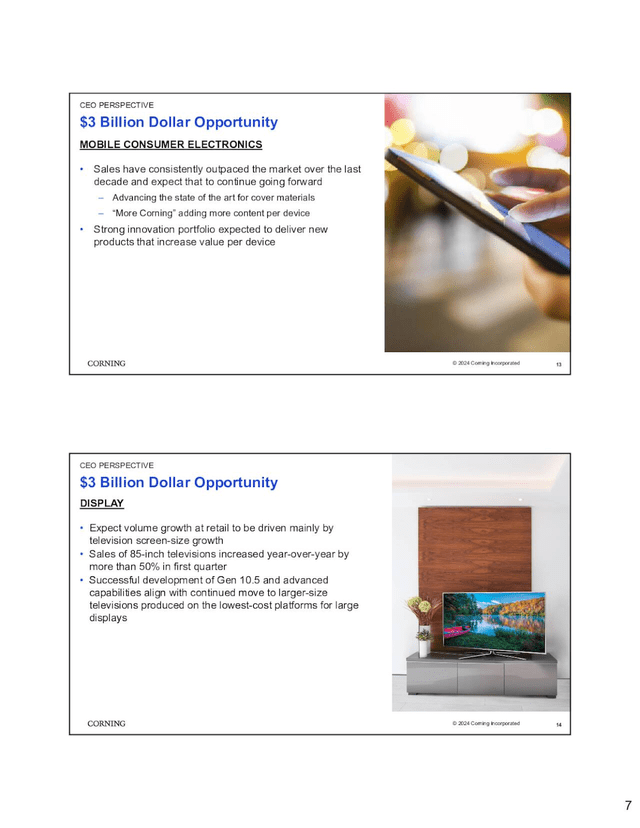My last article on Corning (NYSE:GLW), entitled, “Corning: The 500 Pound Gorilla Glass Stock” appeared on iREIT on the 9th of January. GLW was trading for $30.59 when that piece debuted. I rated Corning as a Buy, and since then, the share price has increased by roughly 46%, well above the 17% gain posted by the S&P 500.
Of course, it didn’t hurt that Corning was the S&P’s best performer last week after posting a 17.5% gain over a five-day period. The jump in share price followed management’s announcement that they were lifting Q2 guidance ahead of this month’s earnings report.
There is a good reason why I described Corning as the 500-pound gorilla of its industry in my prior article. The company has a wide technological advantage over competitors that equates to lower costs and a superior product line. That moat, coupled with the firm’s strong balance sheet and history of well-funded and rapidly growing dividends, keeps GLW on my watch list.
What Caused The Double-Digit Price Surge?
Per a Corning press release, management now forecasts Q2 sales of about $3.6 billion, well above its earlier guidance of $3.4 billion. They also project core EPS for the quarter will land “at the high end of or slightly above management’s guided range” of $0.42 to $0.46 cents.
That news was the impetus for a double-digit increase in the share price early this week. However, a boost in guidance was not the only good news. With that announcement, the company included the following bullets:
- Management believes that first-quarter 2024 will be the lowest quarter for the year.
- The company expects to grow by more than $3 billion in annualized sales in the next three years, driven by a combination of cyclical factors and secular trends. The outlook in each of the company’s markets is positive, and its market positions are strong. Innovative products and deep customer relationships position Corning well to capitalize on these opportunities.
- As Corning captures this growth, management expects to deliver powerful incremental profit and cash flow. The company already has the required production capacity and technical capabilities in place, and the cost and capital are already reflected in its financials.
Corning’s CEO may have added fuel to the fire with the following: “The outperformance was primarily driven by the strong adoption of our new optical connectivity products for Generative AI.”
The AI related growth largely stems from data center sales creating high demand for the company’s new optical connectivity products.
Data centers consist of a front-end network connecting racks of CPUs. These GPU clusters generate extremely large amounts of computing power per rack and require smaller, denser cables. In turn, this requires smaller connector sizes and cable diameters. Corning’s fiber fits that bill to a tee, and management projects demand from that source will drive GLW’s revenue higher.
Corning’s pre-connectorized structured cabling solutions provide significant installation time advantages, with the company’s RocketRibbon cable with Flow Ribbon technology reducing cable diameter by 60% with fibers per cable approaching 7,000.
RocketRibbon cables are up to 28% smaller and as much as 50% lighter. The lighter weight results in less load-bearing tension on aerial installations. The cable can also accommodate up to 2x more fiber per duct, and Corning’s FastAccess technology results in as much as 60% faster cable access.
Why GLW Is Forever In My Portfolio And On My Watchlist
Corning operates in five segments. The firm’s optical communications, display technologies, environmental technologies, and specialty materials segments are the leaders in their respective markets. The fifth segment is the life sciences business.
The AI-related sales fall under GLW’s optical communications segment. Corning invented a process known as outside vapor deposition (OVD). With OVD, the company controls every stage of optical fiber manufacturing.
OVD produces “blanks,” glass the size of a tube of salami. With a single blank, Corning can produce thousands of kilometers of optical fiber from a single blank. Corning also manufactures the furnaces and machines it uses to produce optical fiber. My assumption is that the company does so to protect proprietary technology associated with OVD.
Although fifteen companies manufacture optical fiber from scratch, three hold the lion’s share of that market, with GLW commanding a 17.7% share of the fiber optic cable market.
Mordor Intelligence forecasts the fiber optic cable market will grow at a CAGR of 8.46% from 2024 through 2029, reaching $19.26.
Corning’s display technologies segment, controlling roughly half of the world’s display glass market, is the top dog in an oligopoly shared with AGC Inc., and Nippon Electric Glass. In toto, the three have corralled account for 95% of the global market share.
There are only four Gen 10.5 plants in the world, and GLW operates three of those. This means Corning has the bulk of the globe’s production of the most technologically advanced 65-inch and 75 inch-television screens. That’s because Gen 10.5 reduces the cost of TV panel production by 30% over all other technologies.
During last quarter’s earnings call, management noted that in the first quarter, sales of 85-inch TVs increased by more than 50% year-over-year.

Earnings Presentation
Corning is also moving into other markets to drive revenues. The company partnered with Apple (AAPL) to create durable glass with infused color for the back of iPhone 15 and iPhone 15 Plus devices, along with Ceramic Shield, a cover material with unmatched smartphone performance.
Plus, Corning and AUO Corporation (OTCPK:AUOTY) are using GLW’s patented ColdForm technology, to increase production of AUO’s industry-leading large format curved Automotive display modules.
GLW holds a strong technological lead over rivals. The company’s fusion draw process produces best-of-breed display glass, and with fusion draw, Corning now has about half of the world’s display market share.
It is also important to note that display glass is fragile. Consequently, to drive down shrink costs associated with breakage, Corning builds its production facilities adjacent to their clients’ manufacturing plants. As a result, GLW requires customers to fund 75% of construction costs and enter long-term contracts.
Since new production facilities often cost from one billion to several billion dollars, this translates into Corning establishing long-term, stable relationships with clients.
Perhaps of equal importance is the fact that Corning estimates fusion draw saves approximately $1 billion in investment costs, in addition to savings related to the refining and polishing processes. In turn, these result in gross margins in the upper 30s, roughly ten points better than that of rivals.
Furthermore, with an R&D budget that equals or exceeds $1 billion each year, a sum that leads the industry by a wide margin, Corning cements its lead over rivals.
Last but not least, GLW’s manufacturing facilities exceed current demand, and the company has the capacity to add $3 billion in sales with minimal capex.
Debt, Dividend, And Valuation
GLW yields 2.51%. The payout ratio is just above 67%, and the 5-year dividend growth rate is 8.06%. From 2015 through 2023, Corning increased the dividend by an average of 11% annually.
I contend that the payout ratio is a bit high because the company has been going through a period of low demand. Therefore, management raised the dividend last year by 3.7%. (GLW increased the dividend by 9% or more from 2019 through 2022). I predict that the annual dividend increases will be well below 10% for a year or two and before returning to an approximate 10% annual increase thereafter.
GLW’s debt is rated BBB+, a solid investment grade level.
Cash & equivalents were $1.36 billion, and debt was $7.37 billion at the end of last quarter.
At the end of 2023, Corning’s average debt maturity was 25 years, with no substantial near-term debt maturities.
The company repurchased 48% of shares from 2015 to 2023.
The forward P/E of 33.69x is well above the 5-year average P/E for GLW of 18.87x.
Yahoo! Finance estimates the stock’ 5-year PEG ratio at 1.66x.
Is GLW A Buy, Sell, Or Hold?
For several quarters, demand for Corning’s products was in the doldrums. However, spurred in part by AI related demand, it appears as if the company is in the opening innings of a surge in sales and revenue.
To buttress that claim, let me provide you with excerpts from the last earnings call:
..we believe that the first quarter will be the lowest quarter for the year. We will improve from here.
Second, we expect to grow by more than $3 billion in annualized sales in the mid-term, which we define as within the next three years. The outlook in each of our markets remains positive and our market positions are quite strong.
Third, as we capture this growth, we expect to deliver powerful incrementals, we already have the required production capacity, and technical capabilities in place and the cost and the capital are already reflected in our financials. This is a tremendous opportunity for our shareholders.
As a result, we’re poised to deliver powerful incremental profits and cash flow and generate substantial shareholder value.
Wendell Weeks, CEO
Corning has repeatedly been at the forefront of new growth areas, and now with the firm’s AI related products, it continues to lead the way. From optical fiber and ceramic substrates, to catalytic converters, smartphone covers, and deals with U.S. telecoms to supply fiber for 5G buildouts, GLW is the industry’s technology leader and the lowest-cost producer.
Combine those advantages with a very solid financial foundation and a safe and growing dividend, and one can see why I keep a close eye on the company.
However, with the big boost in share valuation we witnessed last week, I view the shares as somewhat overvalued.
With that in mind, I rate GLW as a Hold.
I have a position in GLW, and I would consider adding substantially to my investment if the stock dropped by about 20%. I would dollar cost average into Corning at a price of approximately $42 a share.
Read the full article here



